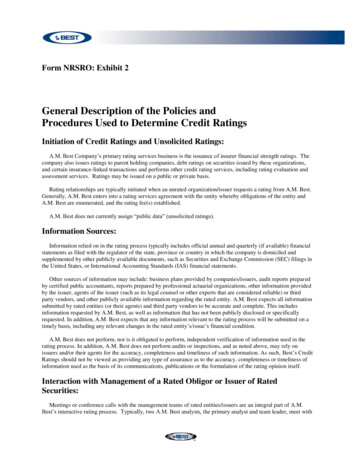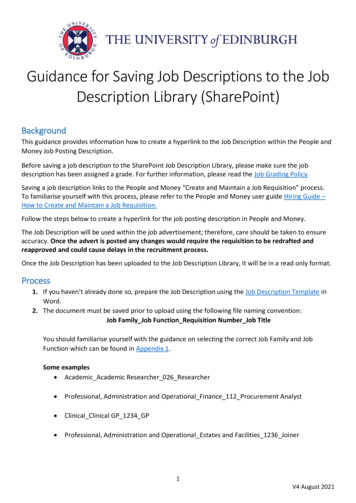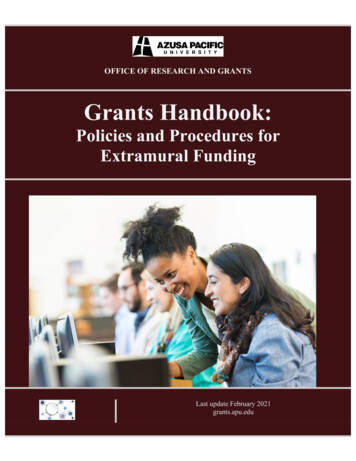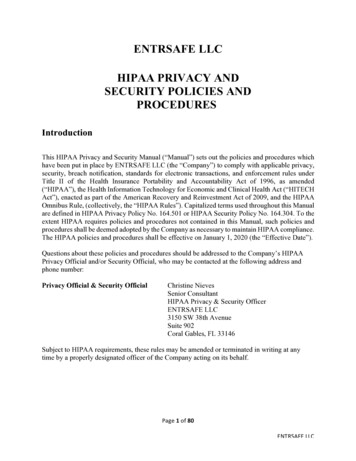
Transcription
Form NRSRO: Exhibit 2General Description of the Policies andProcedures Used to Determine Credit RatingsInitiation of Credit Ratings and Unsolicited Ratings:A.M. Best Company’s primary rating services business is the issuance of insurer financial strength ratings. Thecompany also issues ratings to parent holding companies, debt ratings on securities issued by these organizations,and certain insurance-linked transactions and performs other credit rating services, including rating evaluation andassessment services. Ratings may be issued on a public or private basis.Rating relationships are typically initiated when an unrated organization/issuer requests a rating from A.M. Best.Generally, A.M. Best enters into a rating services agreement with the entity whereby obligations of the entity andA.M. Best are enumerated, and the rating fee(s) established.A.M. Best does not currently assign “public data” (unsolicited ratings).Information Sources:Information relied on in the rating process typically includes official annual and quarterly (if available) financialstatements as filed with the regulator of the state, province or country in which the company is domiciled andsupplemented by other publicly available documents, such as Securities and Exchange Commission (SEC) filings inthe United States, or International Accounting Standards (IAS) financial statements.Other sources of information may include: business plans provided by companies/issuers, audit reports preparedby certified public accountants, reports prepared by professional actuarial organizations, other information providedby the issuer, agents of the issuer (such as its legal counsel or other experts that are considered reliable) or thirdparty vendors, and other publicly available information regarding the rated entity. A.M. Best expects all informationsubmitted by rated entities (or their agents) and third party vendors to be accurate and complete. This includesinformation requested by A.M. Best, as well as information that has not been publicly disclosed or specificallyrequested. In addition, A.M. Best expects that any information relevant to the rating process will be submitted on atimely basis, including any relevant changes in the rated entity’s/issue’s financial condition.A.M. Best does not perform, nor is it obligated to perform, independent verification of information used in therating process. In addition, A.M. Best does not perform audits or inspections, and as noted above, may rely onissuers and/or their agents for the accuracy, completeness and timeliness of such information. As such, Best’s CreditRatings should not be viewed as providing any type of assurance as to the accuracy, completeness or timeliness ofinformation used as the basis of its communications, publications or the formulation of the rating opinion itself.Interaction with Management of a Rated Obligor or Issuer of RatedSecurities:Meetings or conference calls with the management teams of rated entities/issuers are an integral part of A.M.Best’s interactive rating process. Typically, two A.M. Best analysts, the primary analyst and team leader, meet with
management of rated entities/issuers on an annual basis. These meetings are generally supplemented with additionalinteraction between A.M. Best analysts and rated entities/issuers management throughout the year, on an as neededbasis. As previously noted, business plans provided by rated entities/issuers are an extremely valuable source ofinformation for the rating process. Management of rated entities/issuers typically provide detailed business plans,which may include nonpublic information regarding the firm’s strategic and financial planning, and reviews offinancial performance. In addition to providing our analysts with additional insight regarding the underlyingquantitative operating fundamentals of an obligor/issuer, these meetings also provide our analysts with theopportunity to better develop a qualitative assessment of the rated entities’/issuers’ management, which is animportant component of our rating process.Structure and Voting Process of Rating Committees:Ratings analysts and rating committees are required to meet the standards and requirements of, and conductthemselves in accordance with the criteria set forth in A.M. Best’s Code of Conduct and other policies andprocedures that are designed to support fairness and the integrity of the rating process.Once sufficient information has been gathered and analyzed in accordance with the relevant criteria for the typeof rating to be assigned, the primary analyst and team leader present the credit rating recommendation to a ratingcommittee.The assignment of a credit rating by a rating committee, and not by any specific analyst, is essential in promotingand maintaining the integrity, consistency and fairness of the rating process. A rating committee is primarilycomprised of senior analysts who have appropriate knowledge regarding the type of rating to be determined.Procedures for Informing Rated Obligors/Issuers of Rated Securities ofCredit Rating Decisions:Following a committee’s rating decision, obligors/issuers, or their authorized representatives, are contacted byA.M. Best analysts as soon as practicable thereafter and informed of the committee’s rating decision and the criticalinformation and considerations upon which the committee based its decision. Where feasible, and in accordancewith A.M. Best’s Monitoring and Dissemination policy, A.M. Best may forward to the obligor/issuer a draft copy ofthe press release announcing its rating decision to allow the obligor/issuer the opportunity to review the information.A.M. Best forwards such information to the obligor/issuer to allow it the opportunity to ensure that no confidentialinformation is contained therein. For smaller non-public insurers that do not have rated debt securities outstanding,A.M. Best may inform the company by letter of its rating decision. The letter includes the critical information andconsiderations upon which the rating committee based its decision.While the obligor/issuer is in possession of such confidential information, A.M. Best expects it will be treated assuch. With the exception of ratings issued where the lead analyst is employed by A.M. Best Europe – RatingServices Limited, should A.M. Best believe that the confidential information has been misused in any way, or hasbecome known to outsiders for any reason, A.M. Best reserves the right to immediately release its rating decision.European law currently prohibits, under any circumstance, a credit rating agency from publishing a credit ratingopinion until a fixed period of time has elapsed from the time that the rated entity was informed of the credit ratingdecision. This period of time is currently one working day.Procedures for Appealing Rating Decisions:Where feasible and appropriate, rated obligors/issuers are afforded a brief period of time to appeal a ratingdecision. In order to be eligible for an appeal, rated obligors/issuers are required to provide clarification regardingthe principal considerations on which the rating is based, or new information that could reasonably be expected to2
influence a rating committee’s decision. In rare instances in which A.M. Best believes it may take a considerableamount of time to resolve an appeal, the rating may be placed “Under Review.”Procedures for Monitoring, Reviewing and Updating Credit Ratings:Following the assignment of a rating, A.M. Best monitors its credit opinion on a regular and as needed basis.Generally, a credit opinion is formally reviewed at least annually. In addition to the annual credit review process,A.M. Best analysts monitor industry conditions and/or obligor/issuer specific events that could be expected to havean impact on an obligor’s/issue’s creditworthiness on an interim basis. A.M. Best may modify or affirm ratingsfollowing these reviews.A.M. Best disseminates credit rating actions (on public ratings) as soon as practicable (after the obligor/issuer hasbeen informed of its rating decision) on a non-selective basis and free of charge on our publicly accessible web site.These ratings may also be released simultaneously through press releases and through electronic subscriptionservices. Ratings actions will subsequently appear in other A.M. Best printed publications.Procedures for Withdrawing a Rating:As a publisher, A.M. Best reserves the right to withdraw a rating at any time. For example, A.M. Best reservesthe right to suspend or withdrawal a rating if it believes that the information provided to us is inadequate to continuerating an obligor/issuer/issue. The withdrawal of a rating is generally subject to the rating committee process. Ininstances where A.M. Best suspends or withdraws a rating, we issue a press release that includes an explanation asto why the rating was suspended or withdrawn. A rating committee or press release is not required in instanceswhere a rating is withdrawn because a debt or debt-like instrument matures and is no longer outstanding.When a rated entity or issuer requests the withdrawal of an outstanding rating a final rating committee and updatewill be completed and a press release will be issued that includes the outcome of the final rating update and thewithdrawal of the rating.For more information on policies and procedures please visit http://www.ambest.com/nrsro/index.htmlRating Methodology:The following are general descriptions of the methodology/criteria used in determining ratings for the categoriesthat A.M. Best is currently registered as a nationally recognized statistical rating organization. In any given ratingaction, a rating committee will determine what specific aspects of the overall methodology/criteria are relevant tothat particular action.More detailed information on rating methodology/criteria for the types of ratings issued by A.M. Best areavailable on our public web site at ance CompaniesA.M. Best Company’s primary rating services business is the issuance of insurer financial strength ratings. Theprimary objective of Best’s Credit Ratings within the insurance segment is to provide an opinion as to the ratedentity’s ability to meet its senior financial obligations, which for an operating insurance company are its ongoinginsurance policy and contract obligations. The assignment of an interactive rating is derived from an in-depthevaluation of a company’s balance sheet strength, operating performance and business profile, as compared withA.M. Best’s quantitative and qualitative standards.3
In determining a company’s ability to meet its current and ongoing obligations, the most important area toevaluate is its balance sheet strength, since it is the foundation for financial security. Balance sheet strengthmeasures the exposure of a company’s equity or surplus to volatility based on its operating and financial practices.One of the tools used in the evaluation of balance sheet strength for an insurer is Best’s Capital Adequacy Ratio(BCAR), which provides a quantitative measure of the risks inherent in a company’s investment and insuranceprofile, relative to its adjusted capital. A.M. Best’s analysis of the balance sheet also encompasses a thorough reviewof various financial tests and ratios, typically over a five-year period. The same models are used for initial ratingsand for the ongoing monitoring of ratings. Significant changes made to the models and criteria changes are appliedto existing ratings during subsequent rating reviews and in accordance with A.M. Best’s Monitoring andDissemination policy.The assessment of balance sheet strength includes an analysis of an organization’s regulatory filings at both theoperating insurance company and consolidated level. To understand the strength and flexibility of an insurer’sbalance sheet, a variety of tests and measures are reviewed which include an assessment of the corporate capitalstructure, financial leverage, fixed charge coverage, liquidity, and historical sources and uses of capital.While balance sheet strength is the foundation of the rating process, the balance sheet provides only anassessment of capital adequacy at a point in time. A.M. Best views operating performance and business profile asleading indicators when measuring future balance sheet strength and financial security.The term “future” is key, since ratings are prospective and go well beyond a “static” balance sheet view.Profitability is the engine that ultimately drives capitalization, and looking out into the future enables the analyst togauge a company’s ability to preserve and/or generate new capital over time. In many respects, what determines therelative strength or weakness of a company’s operating performance is a combination of its business profile and theability of a company to effectively execute its business strategy.A company that is a strong performer, over time, will generate earnings sufficient to maintain a prudent level ofrisk-adjusted capital and optimize stakeholder value. Strong performers are those companies whose earnings arerelatively consistent and deemed to be sustainable. Because of their track record and better-than-average earningspower, these companies typically benefit from higher ratings and/or lower capital guidelines relative to their peers.On the other hand, companies that have demonstrated weaknesses in their earnings, either through consistentlosses or volatility, are more likely to struggle to maintain or improve capital in the future. For these reasons, thesecompanies typically are rated lower than their counterparts that are strong performers, and/or usually are held tohigher capital guidelines in order to minimize the chance of being downgraded if current trends continue.A.M. Best believes that risk management is the common thread that links balance sheet strength, operatingperformance and business profile. Risk management fundamentals can be found in: the strategic decision-makingprocess used by a company to define its business profile, in the various financial management practices andoperating elements of an insurer that dictate the sustainability of its operating performance, and, ultimately, itsexposure to capital volatility. As such, if a company is practicing sound risk management and executing its strategyeffectively, it will preserve and build its balance sheet strength and perform successfully over the long term –common objectives of both A.M. Best ratings and risk management.Corporate IssuersInsurance holding company structures provide a means to facilitate public ownership of insurers, which areregulated entities, and also provide greater flexibility in accessing the capital markets. A.M. Best assigns IssuerCredit Ratings to these holding companies. The financial strength rating of the operating insurers is an integralcomponent of the assessment of the parent holding company’s ability to repay its financial obligations, and isfundamentally an extension of the review of the operating company that takes into consideration the risks inherent inthe holding company’s operations. Since a holding company’s operations are generally limited in nature and4
primarily exist to fund the operations of subsidiaries, a variety of tests and measures are reviewed. These include anassessment of the corporate capital structure, financial leverage, fixed charge coverage, liquidity, and historicalsources and uses of capital.We include insurance-linked securities issuers that provide reinsurance coverage and capital relief to theirsponsors in the Corporate Issuers class of credit ratings. In some cases where third parties provide peril modelingattachment probabilities associated with such insurance-linked securities, A.M. Best gives consideration to theratings published in the special report, “Best’s Idealized Default Matrix.” The matrix correlates the stochasticallygenerated attachment probabilities to debt ratings before incorporating other considerations that may affect theultimate ratings of the securities.The same models are used for initial ratings and for the ongoing monitoring of ratings. Significant changes madeto the models and criteria changes are applied to existing ratings during subsequent rating reviews and in accordancewith A.M. Best’s Monitoring and Dissemination policy.Issuers of Asset-Backed SecuritiesTo date, all of the company’s ratings in this category relate to securities overwhelmingly backed by insurancerelated collateral. Such collateral consists of trust preferred securities, surplus notes, insurance policies or annuities– all direct obligations of insurers. The Insurance-Linked Securities group relies on the insurer financial strengthratings issued by A.M. Best for modeling transactions collateralized by such insurance obligations. In limitedinstances, A.M. Best may use ratings issued by certain other nationally recognized statistical rating organizations(NRSROs) for obligors not rated by A.M. Best in its modeling of specific transactions. In these instances A.M. Bestuses the ratings as issued by other NRSROs without modification.In determining the credit ratings of asset-backed securities, A.M. Best may consider the following quantitativefactors: the structure of the transaction, including priority of payments; the credit quality of the collateral pool;recoveries in the event of credit defaults; size and number of note tranches being rated; overcollateralization levels;size of the equity tranche; interest rates paid to note-holders; hedges such as swaps, interest rate floors and caps, andother hedging mechanisms; liquidity facility and associated terms/conditions; reserve amount; credit enhancementssuch as guarantees by rated entities; and other structural features included in the transaction.The qualitative factors that may be considered by A.M. Best in the rating process for asset-backed securitiesinclude: the source/quality of the collateral as defined in origination agreements; the strength of legal opinionsassociated with the enforceability of payment obligations by carriers; the integrity of the legal structure; the extent towhich the issuer can demonstrate bankruptcy remoteness from the originator or sponsor; the quality of the variousservice providers in the transaction; the existence of back-up servicer providers; the existence of certainrepresentations and warranties associated with the collateral origination; the track record of the parties involved inthe transaction; and other factors that give an indication of the soundness of the transaction.The Insurance-Linked Securities Group uses the same models for initial ratings and for the surveillance oftransactions. Significant changes made to the model and criteria changes are applied to existing ratings duringsubsequent rating reviews and in accordance with A.M. Best’s Monitoring and Dissemination policy.5
management of rated entities/issuers on an annual basis. These meetings are generally supplemented with additional interaction between A.M. Best analysts and rated entities/issuers management throughout the year, on an as needed basis. As previously noted, business plans provided by rated entities/issuers are an extremely valuable source of











